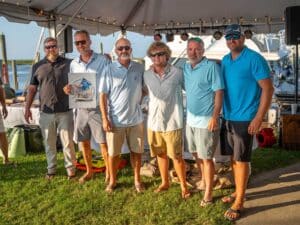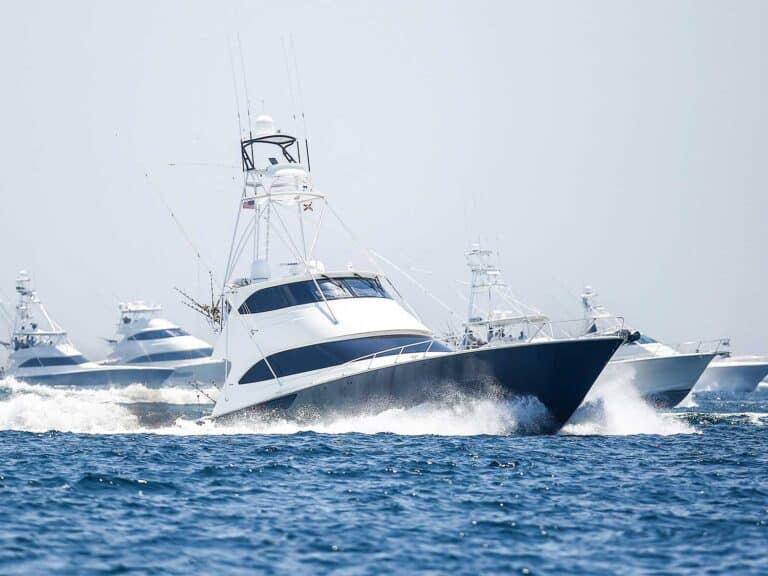



Charles Pereira is the latter-style skipper. He fishes from Nags Head out of Pirate’s Cove Marina 30 to 40 days a year and is a spokesman for Garmin. “Once clear of the inlet, I set the autopilot to get to my waypoint,” he says. “Once there, I set the autopilot on our first trolling heading and get to work setting out the riggers and baits. Then, after listening to radio chatter and looking about, I start adjusting my game plan. Once we get a bite, I take it off and start chasing fish.” While Garmin’s autopilot has a great repertoire of trolling patterns, Pereira doesn’t use them. I had to quiz more than one captain before I found a couple of skippers who regularly tap into the trolling patterns.
Jason Roberts of Clermont, Florida, is one. He’s a charter captain and an electronics technician frequently tasked by Simrad Yachting with installing navigation suites on new yachts. When I experienced some trouble with my self-installed system, Simrad Yachting directed me to Roberts to get it right. I asked him why some captains were unwilling to rely on autopilots to troll a distinct pattern. “I use ’em all the time. So many times when I fish, we have a light crew, and we need everybody in the cockpit to work the lines, set baits and gaff fish. I use the autopilot so I can step away from the helm to help keep the cockpit moving smoothly.” He often relies on his autopilot’s pre-loaded patterns, which let him keep his hands on the tackle while making sure he’s covering an area in an efficient manner. His favorite trolling pattern is the cloverleaf.
“When I fish the Cape Canaveral buoy, I can set the buoy at the center of my pattern and cloverleaf around it all day. You cover a lot of water and do it systematically, thanks to the precision of the pilot,” Roberts says.
Simrad allows anglers to set a figure-eight pattern — that’s just half a cloverleaf — but they also do something else that’s very handy: They allow you to run in an expanding or contracting spiral. Raymarine products have this feature as well.
“My favorite Simrad autopilot feature is the ability to set a zigzag course and adjust the turn angle and turn intervals. This allows me to work both sides of a rip or temperature break without constantly monitoring the helm — a big plus when you find which side they’re biting on!” Roberts says.
Roberts likes the simple 180 pattern, and it’s helped him catch fish more than once when he was running across the stream. “We’ll run over to the Bahamas, cruising at higher speed with the autopilot at 25 to 35 knots, and if we come up on something, I’ll kick back to a lower speed and go back with the autopilot,” Roberts says. His crew uses the time the vessel takes to make the automated turn to set up the riggers and tackle.
All major autopilot makers — Raymarine, Simrad, Garmin and Furuno — include various pattern-trolling features.
Tracking
All captains know that the patterns and autopilot aren’t much help on floating debris. You can’t use a pattern to track and fish a moving object, such as, say, a log in the stream. But they are still invaluale safety helpers when you’re setting up a search pattern. Raymarine’s autopilot will practically weave a net over a given area. Expanding or contracting spirals help too. Both are last-ditch tactics to systematically locate a man overboard, but they’re also good for tracking bait pods on the sonar.
George Mitchell is a competitive angler with ties to Yamaha. “What [the autopilot] does for me,” Mitchell says, “is remove the Uncle Frank phenomenon. Now, I don’t have to keep telling Uncle Frank to pay attention and get back on course. I always use an autopilot when I can, even though I’m pretty hands on when we fish.”
One thing that made it easier for Mitchell to let go at the helm is Furuno’s Safe Helm feature, enabled by the company’s new FPS8 valve block. The valve block piggybacks on the autopilot pump and talks to Furuno’s NavPilot 700. “I can set a course, route or waypoint, and anytime I want to interrupt it, I can grab the helm, and the autopilot senses my steering input and releases control to me,” Mitchell says. “I don’t have to hunt for buttons to disengage it. Then, when I’ve settled on a new course, the Safe Helm notices we’ve settled, and it’ll pick up the new heading and hold it until I turn the wheel again.”
Today’s autopilots can also lock onto, and troll along, a bottom contour. Both Simrad’s AP28 and Furuno’s NavPilot 700 autopilots can lock onto a bottom contour and follow it.
Perhaps the strongest advocate for autopilot fishing is Terry Nugent. He’s usually fishing with a crew of two or three in his Contender 33T out of Cape Cod. For him, the extra hand of Raymarine’s Smart Pilot (tailored for his Mercury Verado engines) is essential.
“I zigzag quite a bit. It’s too easy to get lazy when you’re trolling, and we find we get bit in turns more often than on straight runs,” he says. “We keep the boat jockeying about quite a bit. Once we get a hookup, whoever’s closest to the Raymarine drops a waypoint. Then I go back and help leader the fish. If I have a three-rod knockdown, I can rig the next set of baits while keeping a lookout, and we never lose fishing time. It’s easy to keep an eye forward when working the lines in an open boat. I also have the remote control on my belt and can punch in, say, 10 degrees to turn the boat. Once the fish is in the boat, we go back to the waypoint,” he says. “Cloverleafs and figure eights are my favorite patterns. As soon as we hit the waypoint, we start the pattern with the waypoint at the center.”







